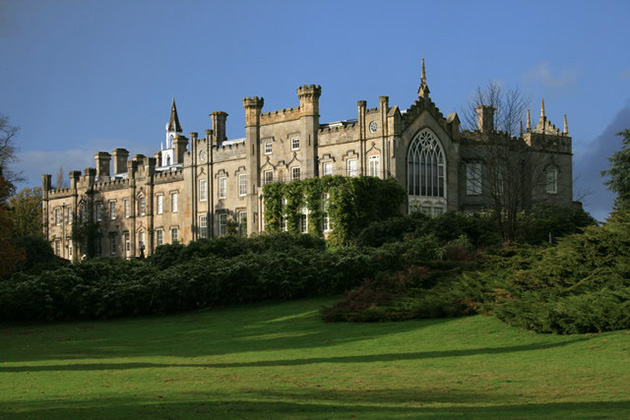The Innocents, Sheffield Park House, Sheffield Green, Uckfield, United Kingdom (1961)
Artist/Designer:
Project Location: England

Style/Period(s):
Gothic
Primary Material(s):
No Primary Material Assigned.
Function(s):
No Function Assigned.
Related Website(s):
Significant Date(s):
1961, 20th Century, 1960-1969
Additional Information:
Publications/Texts in Print:
Babbage, Frances. "The Play of Surface: Theater and "The Turn of the Screw"." Comparative Drama 39, no. 2 (2005): 131-56.
Clark, Jim (2010). Dream Repairman: Adventures in Film Editing. Landmarc Press.
Cotter, Robert Michael "Bobb" (2013). The Women of Hammer Horror: A Biographical Dictionary and Filmography. McFarland.
Frayling, Christpher, The Innocents (London: British Film Institute, 2013).
Hogan, David J. (2016). Dark Romance: Sexuality in the Horror Film. McFarland Classics
Houston, Penelope, “The Innocents,” Sight and Sound 30, no. 3 (Summer 1961): 114–15.
Kael, Pauline (Summer 1962). "The Innocents, and What Passes for Experience". Film Quarterly. Los Angeles, California: University of California Press. 15 (4): 21–7.
Landis, John (2011). Monsters in the Movies. New York: Penguin.
Leeder, Murray (2015). Cinematic Ghosts: Haunting and Spectrality from Silent Cinema to the Digital Era. Bloomsbury USA.
Lichtman, Sarah, and Pat Kirkham. Screen Interiors: From Country Houses to Cosmic Heterotopias. New York, NY: Bloomsbury Publishing, 2021.
Long, Robert Emmet (2008). Truman Capote Enfant Terrible. Bloomsbury USA.
Maltin, Leonard (2015). Classic Movie Guide: From the Silent Era Through 1965. Penguin Publishing Group.
Orr, Leonard (2009). James's The Turn of the Screw. London: A&C Black.
Palmer, James W. "Cinematic Ambiguity: James's "The Turn of the Screw" and Clayton's "The Innocents"." Literature/Film Quarterly 5, no. 3 (1977): 198-215.
Sinyard, Neil (2000). Jack Clayton. Manchester: Manchester University Press.
Slide, Anthony (2013). Fifty Classic British Films, 1932-1982: A Pictorial Record. Courier Corporation.
Solomon, Aubrey (1989). Twentieth Century Fox: A Corporate and Financial History. Lanham, Maryland: Scarecrow Press.
Tredy, Dennis, “Shadows of Shadows: Techniques of Ambiguity in Three Film Adaptations of ‘The Turn of the Screw’: Jack Clayton’s The Innocents (1961), Dan Curtis’s The Turn of the Screw (1974), and Antonio Aloy’s Presence of Mind (1999),” Poetry and Autobiography 5, no 1. (2007): n.p., https://journals.openedition.org/erea/196.
Vincendeau, Ginette (2001). Film/Literature/Heritage: A Sight and Sound Reader. London: British Film Institute.
Walker, Alexander (1974). Hollywood, England: The British Film Industry in the Sixties. London: Joseph.
Wilson, Val, “Black and White and Shades of Grey: Ambiguity in The Innocents,” in John R. Bradley (ed.), Henry James on Stage and Screen, 110 (Basingstoke: Palgrave Macmillan, 2000).
Building Address: Sheffield Park House, Sheffield Green, Uckfield TN22 3QZ, UK
Tags: 1961, Innocents, Film, Interior, Set Design, England, United Kingdom,
Significant Dates: In August 1538, Thomas Howard, 3rd Duke of Norfolk, entertained Henry VIII at Sheffield Park House, From 1776 to 1787, Edward Gibbon lived at Sheffield Park, writing "The History of the Decline and Fall of the Roman Empire" in the library, the current neo-Gothic style of the house dates to the late 1700s, when architect James Wyatt was commissioned by the first Earl of Sheffield to remodel the house and Capability Brown was brought in to design the gardens, according to Savills. 1925, estate sold, the estate was used for exterior shooting in the 1961 film, "The Innocents", where it served as the Gothic "Bly Manor", the setting of the Henry James novella, "Turn of the Screw".
Supporting Staff/ Designers: produced by Jack Clayton, Exterior house designed by James Wyatt, set decorator- Peter James
Viewers should treat all images as copyrighted and refer to each image's links for copyright information.